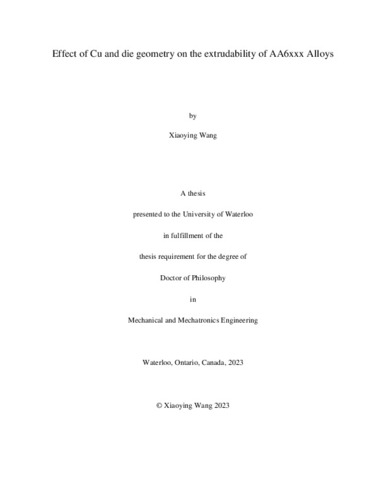UWSpace will be migrating to a new version of its software from July 29th to August 1st. UWSpace will be offline for all UW community members during this time.
Effect of Cu and die geometry on the extrudability of AA6xxx Alloys
| dc.contributor.author | Wang, Xiaoying | |
| dc.date.accessioned | 2023-12-14 14:07:08 (GMT) | |
| dc.date.available | 2023-12-14 14:07:08 (GMT) | |
| dc.date.issued | 2023-12-14 | |
| dc.date.submitted | 2023-12-13 | |
| dc.identifier.uri | http://hdl.handle.net/10012/20162 | |
| dc.description.abstract | A series of extrusion trials were conducted with AA6xxx aluminum alloys with different Copper (Cu) levels to understand the influence of alloy content, die geometry, extrusion ratio and extrusion process parameters (ram speed) on surface cracking and extrudability. In addition, a mathematical model was developed of the extrusion process to complement the experimental trials and provide quantitative information on the thermal mechanical history experienced by the material as a way to help understand the linkages between the extrusion process history, the microstructure formed and surface cracking. The extrusion trials were conducted at Rio Tinto’s facility in Jonquiere, Quebec using their instrumented extrusion press to produce an extruded rod. In these trials, dies with different die bearing geometries and different extrusion ratios were used and the ram speed was increased until surface cracking occurred. These trials were conducted for two (0.6% and 0.9%) of the three different compositions of AA6xxx aluminum alloys with different levels of Cu. The experimental results indicate that die geometry significantly affects surface morphology and crack occurrence. The trials with dies with different die bearing geometries, reveals that choked dies enabled crack-free extrusion at higher speeds, particularly the 12 mm choked die with a 1° angle, outperforming the 25 mm flat die and zero-bearing die. The 35 mm choked die achieved crack-free extrusion even at maximum press speed, yielding smoother surfaces than the other dies. The trials using dies with a higher extrusion ratio generate surface cracks at a lower extrusion speed than the trials using dies with a lower extrusion ratio; this has to do with the higher temperatures that occur at these higher extrusion speeds due to a great amount of work imparted to the material. Finally, the material with higher Cu addition shows surface cracks occur at a lower extrusion speed compared to the material with lower Cu addition. The mathematical model of the extrusion process was developed using the commercial Finite Element Method (FEM) package DEFORMTM 2D. The results from the model predictions were verified by comparing them to the measured extrusion load and temperature. Using a combination of model results and experimental measurements a threshold was determined by analyzing the tensile stress and temperature on the extrudate surface, beyond which surface cracking occurs for different die geometries. This threshold can also be applied to the effect of Cu on the surface cracking. However, for the effect of Cu, the temperature in the extrusion process plays a more important role in surface cracking occurrence. Finally, the extrusion limit diagrams were also constructed based on both the simulation results and the extrusion trial data. The extrusion limit diagram shows the influence of the die bearing geometry, extrusion ratio and Cu content and provide guidance for choosing appropriate extrusion parameters for future studies. | en |
| dc.language.iso | en | en |
| dc.publisher | University of Waterloo | en |
| dc.subject | extrusion | en |
| dc.subject | aluminum alloy | en |
| dc.subject | FEM | en |
| dc.subject | extrusion limit diagram | en |
| dc.title | Effect of Cu and die geometry on the extrudability of AA6xxx Alloys | en |
| dc.type | Doctoral Thesis | en |
| dc.pending | false | |
| uws-etd.degree.department | Mechanical and Mechatronics Engineering | en |
| uws-etd.degree.discipline | Mechanical Engineering | en |
| uws-etd.degree.grantor | University of Waterloo | en |
| uws-etd.degree | Doctor of Philosophy | en |
| uws-etd.embargo.terms | 0 | en |
| uws.contributor.advisor | Wells, Mary | |
| uws.contributor.affiliation1 | Faculty of Engineering | en |
| uws.published.city | Waterloo | en |
| uws.published.country | Canada | en |
| uws.published.province | Ontario | en |
| uws.typeOfResource | Text | en |
| uws.peerReviewStatus | Unreviewed | en |
| uws.scholarLevel | Graduate | en |

